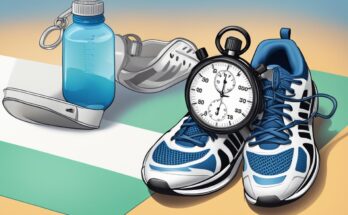When it comes to improving running performance, the question of whether it is better to run more miles or faster miles is a common one. Some runners believe that increasing their weekly mileage is the key to success, while others focus on running faster, shorter distances. The truth is, both strategies can be effective, depending on the individual runner’s goals and abilities.
For runners looking to improve their endurance and overall fitness, running more miles at a slower pace can be an effective strategy. This type of training helps to build aerobic capacity, which is essential for long-distance running. However, for runners looking to improve their speed and performance in shorter races, running faster miles with a focus on speed work and tempo runs may be more effective.
Ultimately, the best approach to running training depends on a variety of factors, including the runner’s goals, experience level, and current fitness level. Working with a coach or trainer can help runners develop a personalized training plan that takes into account these factors, as well as strategies for recovery, strength training, and proper running form.
The Science Behind Running
When it comes to running, there is a lot of science involved. Understanding the science behind running can help runners make informed decisions about their training and improve their performance. In this section, we will explore some of the key scientific concepts that are relevant to running.
Muscle Fibers and Oxygen Delivery
One of the key factors that determines running performance is the type of muscle fibers that a runner has. There are two main types of muscle fibers: slow-twitch and fast-twitch. Slow-twitch muscle fibers are better suited for endurance activities, while fast-twitch muscle fibers are better suited for short bursts of high-intensity activity.
Oxygen delivery is also a critical factor in running performance. Oxygen is needed to fuel the muscles during exercise, and the more oxygen that can be delivered to the muscles, the better the performance.
The Importance of Recovery Days
Recovery days are an essential part of any training program. When a runner exercises, they create small tears in their muscles. These tears need time to heal, and recovery days provide the necessary time for the muscles to repair themselves.
The Role of Heart Rate in Running
Heart rate is an important metric for runners to track. The heart is responsible for pumping blood throughout the body, which delivers oxygen to the muscles. By monitoring their heart rate, runners can ensure that they are working at the appropriate intensity level for their goals.
In conclusion, understanding the science behind running can help runners make informed decisions about their training and improve their performance. By focusing on muscle fibers, oxygen delivery, recovery days, and heart rate, runners can optimize their training and achieve their goals.
The Benefits of Running More Miles
Improved Aerobic Capacity
One of the primary benefits of running more miles is an increase in aerobic capacity. Aerobic capacity is the maximum amount of oxygen that the body can utilize during exercise. By running more miles, the body becomes more efficient at utilizing oxygen, which can lead to improved endurance and performance.
Increased Weekly Mileage and Training Volume
Running more miles also allows for an increase in weekly mileage and training volume. This increase in volume can lead to improvements in overall fitness, including increased endurance, strength, and speed. It also allows the runner to build a solid base of fitness, which can be beneficial for longer distances such as marathons.
The Role of Long Runs in Running Performance
Long runs are an essential component of training for endurance events such as marathons. By running more miles, the runner can increase the length of their long runs, which can lead to improved running performance. Long runs also help to build endurance and mental toughness, which are crucial for longer distances.
Other Benefits of Running More Miles
In addition to the benefits mentioned above, running more miles can also lead to:
- Improved cardiovascular health
- Increased calorie burn and weight loss
- Improved mental health and stress relief
- Increased bone density
However, it is important to note that running more miles can also increase the risk of injury, especially if the runner does not gradually increase their mileage and listen to their body’s signals. It is also important to prioritize recovery and rest days to avoid burnout and overtraining.
Overall, running more miles can be beneficial for improving aerobic capacity, increasing weekly mileage and training volume, and improving long-distance running performance. However, it is important to approach mileage increases gradually and prioritize recovery and rest days to avoid injury and burnout.
The Benefits of Running Faster Miles
Increased Speed and Performance
Running faster miles can have a significant impact on a runner’s speed and performance. By incorporating speed work into their training routine, runners can improve their ability to run at a faster pace over longer distances. This can lead to better race times and increased overall performance.
The Role of Speed Work in Running Improvement
Speed work is an essential component of running improvement. It involves incorporating short bursts of intense running into a training routine to increase speed and improve endurance. By running faster miles, runners can improve their anaerobic fitness, which is essential for maintaining a high level of performance during races.
Threshold Pace and Lactate Threshold
Running faster miles can also help runners improve their threshold pace and lactate threshold. Threshold pace is the pace at which a runner can maintain a high level of effort for an extended period. Lactate threshold is the point at which lactic acid begins to accumulate in the muscles, leading to fatigue and decreased performance. By running faster miles, runners can increase their lactate threshold, allowing them to maintain a higher level of effort for longer periods.
In conclusion, incorporating faster miles into a training routine can have a significant impact on a runner’s speed and performance. By improving anaerobic fitness, threshold pace, and lactate threshold, runners can achieve better race times and increased overall performance.
Strategies for Effective Running
When it comes to improving running performance, there are several strategies that runners can use to achieve their goals. Balancing running more miles and running faster miles, incorporating strength training and other exercises, and focusing on proper running form and technique are all important factors to consider.
Balancing Running More Miles and Running Faster Miles
One common debate among runners is whether it’s better to run more miles or to focus on running faster miles. The truth is, both strategies can be effective for improving performance. For runners looking to increase their endurance, running more miles can be beneficial. However, for runners looking to improve their speed, focusing on running faster miles may be more effective.
It’s important to find a balance between the two approaches that works best for each individual runner. Gradually increasing mileage over time while also incorporating speed workouts can be a great way to achieve both goals.
Incorporating Strength Training and Other Exercises
In addition to running, incorporating strength training and other exercises can also help improve running performance. Strength training can help build muscle and improve overall strength, which can lead to better running form and technique. Other exercises such as yoga or Pilates can help improve flexibility and balance, which can also be beneficial for runners.
It’s important to incorporate these exercises in a way that complements running training, rather than detracting from it. Scheduling strength training or other exercises on non-running days can be a good way to ensure that runners are getting the most benefit from their workouts.
Proper Running Form and Technique
Focusing on proper running form and technique is another important strategy for improving running performance. This includes things like maintaining good posture, landing softly on the feet, and using a mid-foot strike. Proper form can help reduce the risk of injury and improve running efficiency, which can lead to better performance.
Runners can work on improving their form by practicing drills and exercises that focus on specific aspects of running technique. Working with a coach or trainer can also be beneficial for identifying areas that need improvement and developing a plan for addressing them.
Overall, incorporating a variety of strategies can be an effective way to improve running performance. Whether it’s running more miles, running faster miles, incorporating strength training and other exercises, or focusing on proper form and technique, there are many ways for runners to achieve their goals.
Conclusion
In conclusion, the question of whether it is better to run more miles or faster miles ultimately depends on the individual’s goals and preferences.
For those looking to improve endurance and stamina, increasing mileage may be the way to go. Running longer distances at a slower pace can help build cardiovascular fitness and improve overall endurance.
On the other hand, those looking to improve speed and power may benefit more from running shorter distances at a faster pace. This type of training can help improve running efficiency and increase anaerobic capacity.
It is important to note that both types of training can have benefits and should be incorporated into a well-rounded running routine. Additionally, proper rest and recovery are crucial for avoiding injury and maximizing performance.
Ultimately, the key to achieving running goals is consistency and dedication to a well-designed training plan that takes into account individual needs and abilities.
When you’ve reached your goal, reduce your mileage a bit and add some tempo runs and speed work to your program for a short period of time. Running faster certainly produces a quick improvement, but it has less long-term potential to improve running performance than running more. Endurance training adaptations are complex and not fully understood, but there are a couple of key changes occurring inside the body that help make sense of the miles. Running fast on some days is necessary to improve speed, stride and endurance, but successful runners limit fast work to less than 20 percent of their total miles.
For starters, increased mileage influences the heart to become stronger and more efficient at pumping blood. Some good studies have shown that average and maximum running mileage are the best predictors of marathon performance.




